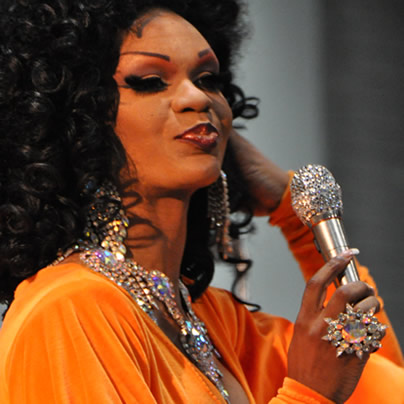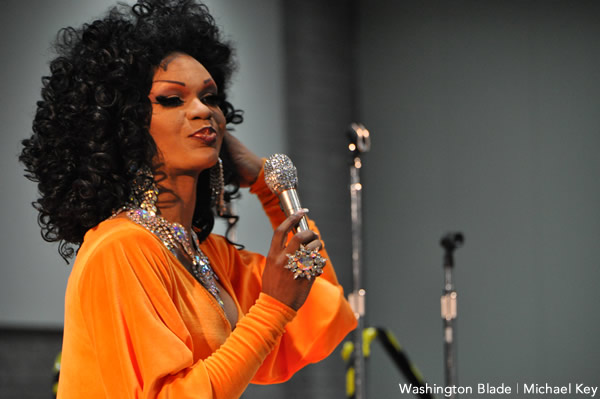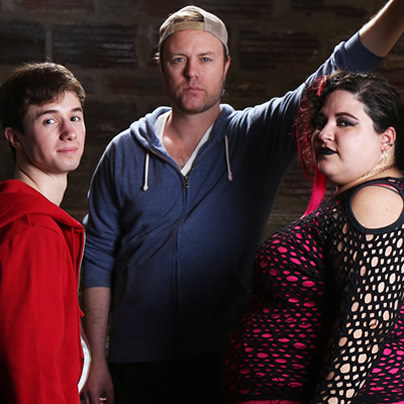Arts & Entertainment
Calendar: March 16
Parties, concerts, events and more through Mach 22

TODAY (Friday)
Green Lantern (1335 Green Court) hosts Mama’s Trailer Park Dance Party tonight upstairs from 10 p.m. to 3 a.m. and “Pop Goes the World: International Dance Party,” starting at 10 p.m. with DJs Aaron Riggins, Della Volla and AVM. Cover is $5 for the Pop. For more information, visit greenlanterndc.com.
Lady Lenore and the eMpire presents “The A List Show” tonight at Remington’s (6396 Pennsylvania Ave., S.E.) for a birthday party for Champagne. The show starts at 11:30 p.m. and there is a $10 cover. For more information, visit remingtonswdc.com.
The HIV Working Group will be doing Outreach tonight at Town (2009 8th St., N.W.) during Bear Happy Hour starting at 7 p.m. and continuing throughout the night until midnight. Volunteers are needed. For more information, visit thedccenter.org.
Strathmore’s Friday Night Eclectic continues tonight with a St. Patrick’s Day celebration featuring Vox Populi and Euphonism, two of D.C.’s a capella groups at the Mansion (10701 Rockville Pike, North Bethesda) at 9 p.m. Tickets are $10 in advance and $12 at the door. Doors open at 8 p.m. For more information and to purchase tickets, visit strathmore.org.
Group GrooveLily plays Wolf Trap (1645 Trap Rd., Vienna) tonight at 8 p.m. with “Sleeping Beauty Wakes: In Concert.” The story takes place in a sleep disorder clinic, with Sleeping Beauty displaced after several hundred years of sleeping.
Touchstone Gallery (901 New York Ave., N.W.) has a new exhibit on display, “Tracks,” featuring photographs by Paul McCutchen. The exhibit will be up through April 1. The gallery is open from11 a.m. to 6 p.m. For more information, visit touchstonegallery.com.
Saturday, March 17
Spunk-E Productions presents “Ink” at Green Lantern (1335 Green Court, N.W.) tonight from 10 p.m. to 2 a.m. featuring music by DJ T-one and St. Patrick’s Day drink specials all night.
Zeba Bar (3423 14th St., N.W.) hosts “Ottomania: A Transglobal Balkanic Dance Party” tonight from 10 p.m. to 3 a.m. with DJs BEATrix, India Nile/DJ Trash and vANNIEty Kills with special guest DJ Meat Hook. This is a free event.
The Ladies of LURe present “Bare” tonight with at Cobalt (1639 R St., N.W.) with DJS Rosie and Keenan and the DysRuXion Dancers from 10 p.m. to 3 a.m.
John Eaton plays Wolf Trap (1645 Trap Rd., Vienna) tonight with bassist Tommy Cecil at 7:30 p.m. Tickets are $25 and can be purchased online at wolftrap.org.
Comedian Barry Rothbart performs at Riot Act Comedy Theater (801 E St., N.W.) tonight at 8 and 10:30 p.m. Tickets range from $17 to $20 and are available online at riotactcomedy.com.
Black Cat (1811 14th St., N.W.) presents Right Round’s 10th anniversary party tonight at 9 p.m. Tickets are $10 and available online at blackcatdc.com.
Evolve Urban Arts Project (1375 Maryland Ave., N.E.) is hosting a meet and greet with artist Beth Cartland for her exhibit, “Texture, Line and Color,” on display through March 23.
STR8-N-UP Productions presents “The Dance,” a play that follows two women and the men in their lives through their experiences with HIV and their opposite outcomes, tonight at the THEARC Theater (1907 Mississippi Ave., S.E.) at 3 and 7 p.m. There is no admission and free HIV testing will be provided on site.
Sunday, March 18
Monet Dupree presents “A Throw Back Party” tonight at Remington’s (639 Pennsylvania Ave., S.E.) at 8 p.m.
Professionals in the City and the D.C. Center are hosting a speed dating event for lesbian and bisexual women at Chi-Cha Lounge (1624 U St., N.W.) from 7:30 to 9:30 p.m. tonight. Attendees will date for about an hour and then be able to mingle with everyone. After the event, matches can be made online. Tickets are $30 if purchased by Friday. For more information, visit thedccenter.org.
Busboys & Poets presents “Borderlines: A Bilingual Spanish-English Open Mic” tonight at 5 p.m. in the Zinn room of its Hyattsville location (5331 Baltimore Ave., Suite 104) hosted by Henry Mills. The sign-up sheet opens at 4 p.m.
Comedian Brad Trackman performs at Riot Act Comedy Theater (801 E St., N.W.) tonight at 7 p.m. Tickets are $20 and available online at riotactcomedy.com.
Monday, March 19
The D.C. Center Development Committee is meeting today from 7 to 8 p.m. at the Center (1318 U St., N.W.). The committee works to enhance and diversify the Center’s financial resources.
Busboys & Poets presents “Other People’s Poetry” tonight its Shirlington location (4251 S Campbell Ave.) in Arlington at 8 p.m. hosted by Rebecca Dupas. Admission wristbands are $4 and will be sold all day in the Global Exchange store beginning at 10 a.m. until sold out.
Black Fox Lounge (1723 Connecticut Ave., N.W.) hosts “La-Ti-Do,” a spoken word/musical theatre cabaret series, tonight from 8:30 to 10 p.m. There is a $10 cover.
Tuesday, March 20
Kuriosity and Co presents “The Main Event,” a weekly talent competition at Remington’s (639 Pennsylvania Ave., S.E.). Showtime is at 9:30 p.m. This week’s theme is “Show Your Talent.” Admission is $5.
Celtic Crossroads peforms at Wolf Trap (1645 Trap Rd., Vienna) tonight at 8 p.m. Tickets are $27 and available online at wolftrap.org. The group will also be performing Wednesday.
Wednesday, March 21
The D.C. Ice Breakers has its monthly skate and social tonight. The group will be skating at Kettler Capitals Iceplex (627 N. Glebe Rd.) in Arlington from 8 to 9 p.m. then they’ll hit a local bar for a social hour. Skating is $8 and skate rentals are $3.
The Tom Davoren Social Bridge Club for gay bridge players meets tonight for social bridge at the Dignity Center (721 8th Street, S.E.). No partner is needed. Visit lambdabridge.com for details and click on “social bridge in Washington.”
LYFE Mentors, a new organization at the D.C. Center (1318 U St., N.W.) is hosting a luncheon to discuss the new mentoring program for LGBT youth and recruit new stakeholders in the effort. For more information, visit thedccenter.org.
Thursday, March 22
The Fridge (516 1/2 8th St., S.E.) is hosting a lecture with Ian Nagosaki with its multimedia exhibit “King Me: Studies in the Uncivilized World” tonight at 7 p.m. The exhibit closes March 29.
The Lambda Sci-Fi Book Group meets today at 1425 S St., N.W. at 7 p.m. This month’s book is “Glasshouse” by Charles Stross. Attendees are asked to bring a snack and/or non-alcoholic drink to share. For more information, email [email protected], [email protected] or visit the group’s website lambdascifi.org.
Bars & Parties
Mixtape Sapphics hosts holiday party on Dec. 13
‘Sugar & Spice’ night planned for Saturday

Mixtape Sapphics will host “Sapphic Sugar & Spice: A Naughty-Nice Mixtape Holiday Party” on Saturday, Dec. 13 at 4 p.m. at Amsterdam Lounge.
This is a festive, grown holiday party for queer women and sapphics 35 and older at Revolt’s Christmas pop-up. There will be music, joy, and an optional White Elephant.
This is Mixtape Sapphics’ first-ever holiday party — a cozy, flirty, intentionally grounded night created just for queer women and sapphics 35+ who want real connection, festive joy, and a warm place to land at the end of the year.
Tickets start at $13.26 and can be purchased on Eventbrite.

Friday, December 12
“Center Aging Friday Tea Time” will be at 12 p.m. in person at the DC Center for the LGBT Community’s new location at 1827 Wiltberger St., N.W. To RSVP, visit the DC Center’s website or email [email protected].
Go Gay DC will host “LGBTQ+ Community Happy Hour” at 7 p.m. at Freddie’s Beach Bar and Restaurant. This event is ideal for making new friends, professional networking, idea-sharing, and community building. This event is free and more details are available on Eventbrite.
Women in Their Twenties and Thirties will be at 8 p.m. on Zoom. This is a social discussion group for queer women in the Washington, D.C. area. For more details, go to Facebook.
Saturday, December 13
Go Gay DC will host “LGBTQ+ Community Brunch” at 12 p.m. at Freddie’s Beach Bar & Restaurant. This fun weekly event brings the DMV area LGBTQ+ community, including allies, together for delicious food and conversation. Attendance is free and more details are available on Eventbrite.
The DC Center for the LGBT Community will host “Sunday Supper on Saturday” at 2 p.m. D.C.’s queer community will gather for good food, laughter, and community. For more information, email [email protected].
Sunday, December 14
SADBrunch will host “HokiSlay Drag Brunch” at 12 p.m. at Throw Social. This festive affair brings fierce performances, over-the-top holiday looks, and more sparkle than a tinsel explosion. Expect powerhouse lip-syncs, laughter, and cheer hotter than your spiked cocoa. Cake Pop will host the event. Tickets cost $28.52 and are available on Eventbrite.
Monday, December 15
“Center Aging: Monday Coffee Klatch” will be at 10 a.m. on Zoom. This is a social hour for older LGBTQ+ adults. Guests are encouraged to bring a beverage of choice. For more information, contact Adam ([email protected]).
Genderqueer DC will be at 7 p.m. on Zoom. This is a support group for people who identify outside of the gender binary, whether you’re bigender, agender, genderfluid, or just know that you’re not 100% cis. For more details, visit genderqueerdc.org or Facebook.
Tuesday, December 16
Center Bi+ Roundtable will be at 7 p.m. on Zoom. This is an opportunity for people to gather and discuss issues related to bisexuality or as Bi individuals in a private setting. Visit Facebook or Meetup for more information.
The DC Center for the LGBT Community will host “Self-Defense Class with Avi Rome” at 12:30 p.m. Rome is a proud member of the LGBTQ community and a full-time martial arts instructor with 25 years of teaching experience. He holds a Fifth Degree Black Belt in Jhoon Rhee Tae Kwon Do and is the director of the studio’s Adaptive Tae Kwon Do program for students with special needs. He has also run numerous self-defense workshops for various groups and situations. For more details, visit the center’s website.
Wednesday, December 17
Job Club will be at 6 p.m. on Zoom upon request. This is a weekly job support program to help job entrants and seekers, including the long-term unemployed, improve self-confidence, motivation, resilience and productivity for effective job searches and networking — allowing participants to move away from being merely “applicants” toward being “candidates.” For more information, email [email protected] or visit thedccenter.org/careers.
Asexual and Aromantic Group will be at 7 p.m. on Zoom. This is a space where people who are questioning this aspect of their identity or those who identify as asexual and/or aromantic can come together, share stories and experiences, and discuss various topics. For more details, email [email protected].
Thursday, December 18
The DC Center’s Fresh Produce Program will be held all day at the DC Center for the LGBT Community. People will be informed on Wednesday at 5 p.m. if they are picked to receive a produce box. No proof of residency or income is required. For more information, email [email protected] or call 202-682-2245.
Virtual Yoga Class will be at 7 p.m. on Zoom. This free weekly class is a combination of yoga, breath work and meditation that allows LGBTQ+ community members to continue their healing journey with somatic and mindfulness practices. For more details, visit the DC Center’s website.
Egypt
Iran, Egypt object to playing in Seattle World Cup ‘Pride Match’
Game to take place on June 26

Iran and Egypt have objected to playing in a “Pride Match” that will take place in Seattle during the 2026 World Cup.
The Egyptian Football Association on Tuesday said it told FIFA Secretary General Mattias Grafström in a letter that “it categorically rejects holding any activities related to supporting (homosexuality) during the match between the Egyptian national team and Iran, scheduled to be held in Seattle, USA, on June 26, 2026, in the third round of the group stage of the 2026 World Cup.” Football Federation Islamic Republic of Iran President Mehdi Taj told ISNA, a semi-official Iranian news agency that both his country and Egypt “protested this issue.”
The 2026 World Cup will take place in the U.S., Canada, and Mexico. The draw took place at the Kennedy Center on Dec. 5.
Iran is among the handful of countries in which consensual same-sex sexual relations remain punishable by death.
The State Department’s 2023 human rights report notes that while Egyptian law “did not explicitly criminalize consensual same-sex sexual activity, authorities regularly arrested and prosecuted LGBTQI+ persons on charges including ‘debauchery,’ prostitution, and ‘violating family values.’” Egyptian authorities “also reportedly prosecuted LGBTQI+ individuals for ‘misuse of social media.’”
“This resulted in de facto criminalization of same-sex conduct and identity,” notes the report.
The 2024 human rights report the State Department released earlier this year did not include LGBTQ-specific references.
Soccer has ‘unique power to unite people across borders, cultures, and beliefs’
The June 26 match between Iran and Egypt coincides with Seattle Pride. The Washington Post reported the Seattle FIFA World Cup 2026 Local Organizing Committee decided to hold the “Pride Match” before last week’s draw.
“As the Local Organizing Committee, SeattleFWC26’s role is to prepare our city to host the matches and manage the city experience outside of Seattle Stadium,” said SeattleFWC26 Vice President of Communications Hana Tadesse in a statement the committee sent to the Washington Blade on Wednesday. “SeattleFWC26 is moving forward as planned with our community programming outside the stadium during Pride weekend and throughout the tournament, partnering with LGBTQ+ leaders, artists, and business owners to elevate existing Pride celebrations across Washington.”
“Football has a unique power to unite people across borders, cultures, and beliefs,” added Tadeese. “The Pacific Northwest is home to one of the nation’s largest Iranian-American communities, a thriving Egyptian diaspora, and rich communities representing all nations we’re hosting in Seattle. We’re committed to ensuring all residents and visitors experience the warmth, respect, and dignity that defines our region.”
The 2034 World Cup will take place in Saudi Arabia.
Consensual same-sex sexual relations remain punishable by death in the country. The 2022 World Cup took place in neighboring Qatar, despite concerns over the country’s anti-LGBTQ rights record.


















